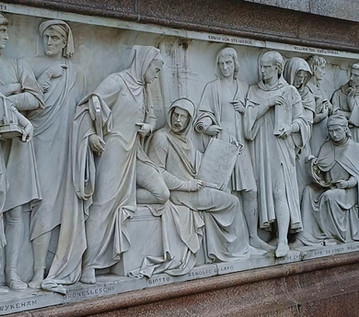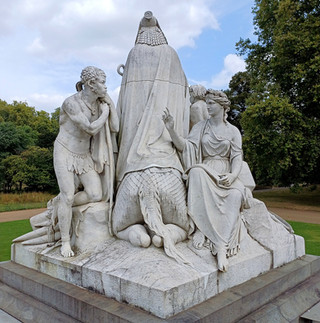Simple brick arches support one of Victorian London's most elaborate monuments.

I recently joined the first ever public tour of the Albert Memorial's hidden undercroft, whose plain brick arches are in stark contrast to the magnificently detailed complexity visible above.
But first, some background on Prince Albert and the ambitious monument constructed in his memory.
Walks available for booking
For a schedule of forthcoming London On The Ground guided walks, please click here.
The Albert Memorial in Kensington Gardens was Queen Victoria's posthumous love letter to her husband Prince Albert, who died in 1861.

An extraordinarily detailed and lavish neo-Gothic composition, it embodies Albert's interests in the arts and sciences and captures 19th century imperial Britain's view of itself and its role in the world.
The memorial was completed in 1872, when Victoria inspected it to her satisfaction, although the statue of Albert was not installed until 1876. The overall design was by architect George Gilbert Scott, who received a knighthood for his work. A dozen of the leading sculptors of the age created a huge number of carved and cast figures for the monument.
Victoria and her German first cousin Albert were married in 1840, not yet three years into her reign, when they were both just 20 years old. As was common with royal nuptials, theirs was an arranged marriage, but it grew to be one of genuine love and affection. The couple had nine children and were devoted to one another.
Over the next 21 years, Prince Albert played an important part in the life of the Queen and the nation.
He modernised the running of the royal household and took an active interest in affairs of state, science and commerce. In an age of paternalistic philanthropy in the upper classes, he promoted causes such as educational reform, the welfare of the working classes and the abolition of slavery globally.
After Albert died at the age of 42 in 1861, after two years of increasing stomach pains, the Queen never emerged from mourning, wearing black for the rest of her life (which lasted another 40 years).
She kept her beloved's dressing gown with her in bed, where she also kept a life-size plaster cast of his hand to hold. These were eventually among the items buried in her coffin with her.
Victoria commissioned the Albert Memorial, although Parliament voted £50,000 towards the £120,000 cost (around £11.5 million in 2024 money) and the public also contributed. It stands in Kensington Gardens opposite the Royal Albert Hall, also constructed in his honour, in a district rich with his legacy.

Nearby are the site of the Great Exhibition of 1851 (which Albert organised), the Victoria and Albert Museum, the Science Museum, the Natural History Museum and Imperial College. This area of Kensington, dubbed 'Albertopolis', was purchased with the profits of the Great Exhibition, on Albert's advice, to be a cultural and educational centre.
The Memorial is very large, reaching a height of 176 feet (54 metres). It consists of an elaborately decorated canopy, known as a ciborium, of the form that stands over the altar in a medieval church. Architect George Gilbert Scott was influenced by the series of 12 Eleanor Crosses erected from Lincoln to Charing Cross by Edward I in the late 13th century in honour of his queen.
The upper faces of the ciborium are adorned with mosaics representing the arts, designed by the partnership Clayton and Bell, who mainly specialised in stained glass windows, and manufactured by Venetian firm Silviati.

The outside of the canopy also displays statues representing angels (by John Birnie Philip), the virtues (by James Frank Redfern), and the sciences and practical arts (by Henry Hugh Armstead and John Birnie Philip).
Underneath the canopy sits a 14 ft (4.3m) high gilded statue of a seated Prince Albert holding his copy of the Great Exhibition catalogue.
The statue of Prince Albert:
Click on any picture to enlarge
The four year delay between the construction of the monument and the installing of its central figure was due to the death of not one, but three people involved in creating the sculpture.
The sculptor chosen by the Queen was Carlo Marochetti, an Italian whose work was much admired by Victoria and Albert. However, George Gilbert Scott did not like Marochetti's first two models of his statue of Albert. Marochetti was working on a third when he died towards the end of 1867.
His replacement was British sculptor John Henry Foley, who also created the Asia sculptural group for the Memorial (see below). Foley's design was successful, but he died in 1874 before it was fully cast and assembled. The statue of Albert was completed by Thomas Brock.
The casting was done by a Southwark foundry, Henry Prince and Company, but completion of the statue was further delayed by the death of Henry Prince. It was finally placed in the memorial in November 1875, but hidden from public view until the gilding was finished in March 1876.
Just outside the base of the canopy are four stone sculptural groups depicting four industries: agriculture (by William Calder Marshall), commerce (by Thomas Thornycroft), engineering (by John Lawlor) and manufacturing (by Henry Weekes).
The four industries:
Click on any picture to enlarge
Underneath the four industries, a sculpted relief known as the Frieze of Parnassus adorns the pedestal on which the statue of Albert sits.
The Frieze contains 169 life-size figures - from the creative arts, literature and architecture -from ancient times to the 19th century. They were carved by two sculptors, working in situ through the year in all weathers and are arranged into four groups, one on each face of the monument.
Henry Hugh Armstead carved the composers and poets on the south side and the painters on the east side.
Composers and poets:
Click on any picture to enlarge
Painters:
Click on any picture to enlarge
The sculptors on the west side and the architects on the north side are the work of John Birnie Philip. For many of them, Philip included examples of their work, either clasped in their hands or in the background. Scott was included among the architects, but only in profile and in the background.
Sculptors:
Click on any picture to enlarge
Architects:
Click on any picture to enlarge
At the outer corners of the monument and down some steps from the Frieze, there are more groups of sculptures portraying four continents: Africa (by William Theed), the Americas (by John Bell), Asia (by John Henry Foley) and Europe (by Patrick McDowell).
Four continents:
Click on any picture to enlarge
The area bounded by the four continent sculptures is enclosed by ornate railings and is usually closed to the public.

Periodically, tours that go behind the railings to see the Memorial from close up are run by the Royal Parks, which is responsible for it. These include climbing the steps to see the very impressive and detailed Parnassus Frieze.
Imposing and stately from a distance, the Albert Memorial reveals an astonishing range and depth of detail the closer you approach it.

Something that the Memorial hardly ever reveals, however, is its extensive undercroft. The monument is so massive that it needs foundations to support its weight, particularly as the ground on which it was built is not flat.
These foundations are a series of brick arches, arranged in concentric squares around a central supporting chamber and standing on a concrete base.

Above ground, the only clue to the undercroft's existence is an easily missed metal cover in the grass near the southwest corner of the Memorial.
Last month, it was opened up for the first undercroft tour organised by the Royal Parks. Thanks to a friend's change of plans, I had the chance last month to join the tour.

Called the 'Albert Memorial Under and Over Experience', the tour also included the more common experience of going behind the railings above ground to see the sculptures up close.
This excellent tour offered everything I didn't realise I really wanted to know about the Albert Memorial. I even got to wear a hi-vis gilet and hard hat for the descent into the undercroft!

You can see a brief video I made of my visit to the undercroft on my YouTube channel at this link.
After the very thorough look at the Memorial, we walked to the nearby site of the Great Exhibition of 1851 and ended with tea and cake.
Keep an eye out on the Royal Parks website and its Eventbrite account to see if this tour is repeated.
Click on any picture to enlarge
Walks available for booking
For a schedule of forthcoming London On The Ground guided walks, please click here.



























































































Brilliant! In my mind I always thought the Albert Memorial was rather small. How wrong I was! I will be sure to take a closer look next time I’m in the area.